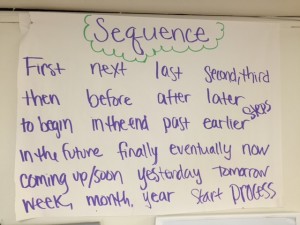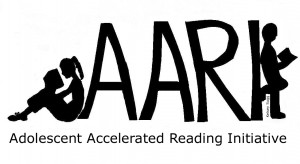 As a teacher who works with struggling readers, my favorite time of year is the end of the semester. It’s then that I assess students’ progress. When I give them their results, some can’t believe it. Some want to call their parents to share the good news. And some even cry. They all beam with pride.
As a teacher who works with struggling readers, my favorite time of year is the end of the semester. It’s then that I assess students’ progress. When I give them their results, some can’t believe it. Some want to call their parents to share the good news. And some even cry. They all beam with pride.
What’s not to love?
The time of year that is a close second, though, is the just-past-halfway-point. Yes, I know that this is when students and teachers tend to count down toward the next break, with nothing but survival on their minds. But in the Adolescent Accelerated Reading Initiative, or AARI, things are starting to get exciting.
AARI is a program that quickly brings struggling students up to grade level, using a variety of research-supported techniques. During the first few weeks of AARI, we learn a lot about an author’s purpose. We also learn how authors achieve their purposes through the organization of their texts. We focus heavily on text structures and “mapping” a text’s organization, which shows the relationships between facts and information.
It’s at this point in the year, this just-past-halfway-point, when my students start to recognize text structures in their books—on their own. I love this because it shows me that they’re ready for more. They’re ready to start transitioning to grade-level texts.
The Real-World Connection
There are other signs that they’re ready. Sometimes a student will burst into the room at the beginning of the period and exclaim, “You’ll never believe what we’re doing in Chemistry! The teacher gave us a chart, and he didn’t even realize it was a matrix!”
Seeing kids make these connections to their learning is what makes my work so vital. It’s why even as I’m launching the first weeks of the class, my focus is always on my endpoint: helping students use their intervention in relevant, real-world applications.
This real-world focus starts early. Toward the beginning of the semester, we start talking about our text structures in the “real world.” I start this discussion by asking students what clues readers have in other, more difficult texts.
Together, we make anchor charts of “clue” words and phrases that writers use to signal that they are using a particular text structure to organize their thoughts. We post these in the room and add to them as we encounter more. Having these word banks arms students with tools to start recognizing text structures when the texts aren’t so easy.
Starting Small
Once students have these tools in their tool belt, I start introducing higher-level texts. They’re gaining proficiency, but they are still struggling readers, and they’re not ready for the full independence of working with long texts on their own.
So I start to give them a little taste: an appetizer, if you will. To do this and to make the reading relevant to them, I get my texts snippets from their content area textbooks.
I bring these “appetizers” in to class and “serve” them at the beginning of class as our warm-up. To scaffold their reading, I give them a focused purpose. They may have to answer a question about the author’s purpose, or they may have to identify a text structure. It helps them to see that their practice work with the easier texts is helping them to approach the more daunting texts they see in their classes all the time.
Lessons for ELA Classrooms
Finding this balance is crucial not only in intervention classes like AARI, but in all reading. We know our students have some pretty high expectations set by the Common Core State Standards and assessments like the redesigned SAT. Teachers want students to be able to access their texts, but they also know the value of exposing them to more challenging options. To help achieve this balance, I’ve found that these steps are key:
- Arm students with tools to help them bridge the gap between accessible and challenging texts. Word banks are a great start.
- Introduce more difficult texts slowly and in small chunks.
- Gradually build to a combination of high-level, high-skill texts that require more stamina.
 Megan Kortlandt is a secondary ELA consultant and reading specialist for the Waterford School District. In the mornings, she teaches AARI and literacy intervention classes at Waterford Mott High School, and in the afternoons, she works with all of Waterford’s middle and high school teachers and students in the Curriculum, Instruction, and Assessment department. Additionally, Megan works with Oakland Schools as an instructional coach for AARI. She has presented at various conferences including the Michigan Council for Teachers of English and Michigan Reading Association annual conferences.
Megan Kortlandt is a secondary ELA consultant and reading specialist for the Waterford School District. In the mornings, she teaches AARI and literacy intervention classes at Waterford Mott High School, and in the afternoons, she works with all of Waterford’s middle and high school teachers and students in the Curriculum, Instruction, and Assessment department. Additionally, Megan works with Oakland Schools as an instructional coach for AARI. She has presented at various conferences including the Michigan Council for Teachers of English and Michigan Reading Association annual conferences.

 As a teacher who works with struggling readers, my favorite time of year is the end of the semester. It’s then that I assess students’ progress. When I give them their results, some can’t believe it. Some want to call their parents to share the good news. And some even cry. They all beam with pride.
As a teacher who works with struggling readers, my favorite time of year is the end of the semester. It’s then that I assess students’ progress. When I give them their results, some can’t believe it. Some want to call their parents to share the good news. And some even cry. They all beam with pride.

 Now that I’ve covered the
Now that I’ve covered the  are probably not a struggling reader. But you probably have struggled with learning something new or tackling something difficult. You could try something new, or bring in your graduate school work and explain what is difficult for you–anything to show that improvement takes time, practice, and strategies to succeed.
are probably not a struggling reader. But you probably have struggled with learning something new or tackling something difficult. You could try something new, or bring in your graduate school work and explain what is difficult for you–anything to show that improvement takes time, practice, and strategies to succeed.
 Even if your group of struggling readers is blossoming, it’s important to consider how your community can continue to grow and thrive. That’s especially true for classrooms organized around the
Even if your group of struggling readers is blossoming, it’s important to consider how your community can continue to grow and thrive. That’s especially true for classrooms organized around the  Break bread together. One Friday a month, my classes would have what came to be known as “Food Fridays.” It usually started with my bringing in some snacks (think Costco/Sam’s Club granola bars or crackers). Some years, it took on a life of its own. Students would initiate elaborate sign-up sheets, and they would bake brownies and frost cupcakes. Other years, the kids were just happy to have a little something to eat while we worked.
Break bread together. One Friday a month, my classes would have what came to be known as “Food Fridays.” It usually started with my bringing in some snacks (think Costco/Sam’s Club granola bars or crackers). Some years, it took on a life of its own. Students would initiate elaborate sign-up sheets, and they would bake brownies and frost cupcakes. Other years, the kids were just happy to have a little something to eat while we worked.